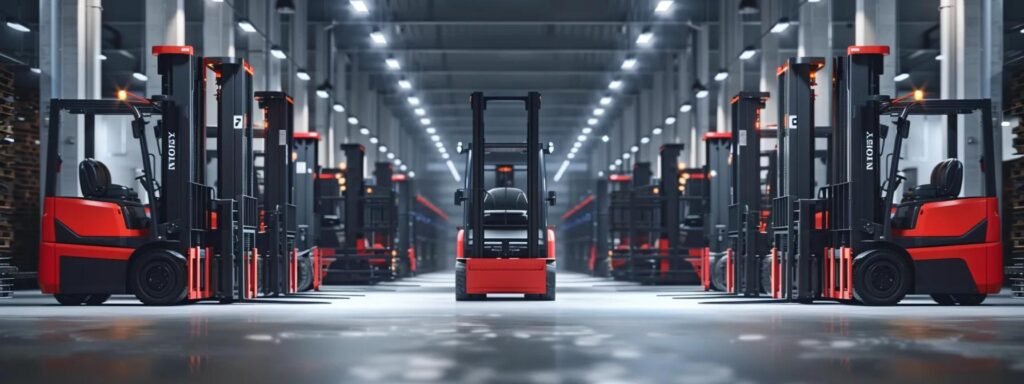
Transform Your Warehouse with Top-Rated Material Handling
Introduction
Efficient material handling is essential for a successful warehouse operation. Businesses depend on selecting, using, and maintaining equipment to optimize storage, streamline distribution, and ensure safety. Warehouse managers must balance performance, cost efficiency, and regulatory compliance when choosing equipment suitable for their facilities. This article explores key categories—forklifts, conveyor systems, pallet jacks, and safety practices—while also addressing maintenance, used equipment purchasing benefits, and expert consultation.
Readers will gain insights into comparing electric and internal combustion forklifts, understanding conveyor system advantages, and evaluating pallet jack options. By answering common questions and providing actionable tips, the guide helps logistics professionals make informed decisions that can reduce downtime, boost productivity, and ensure compliance.
What Are the Best Forklifts for Warehouses?

Forklifts are vital for quickly and safely transporting loads in warehouses. They come in various designs and power sources to meet diverse operational needs.
Which Types of Forklifts Are Ideal for Warehouse Use?
Ideal forklifts include counterbalance models, reach trucks, order pickers, and pallet jacks. Counterbalance forklifts can lift heavy loads without extra counterweights; reach trucks work well in high-density storage with their extended reach; order pickers efficiently retrieve items; and pallet jacks move goods over short distances. For example, a center-pivot reach truck maximizes vertical space in narrow aisles. Compact design, advanced maneuverability, stability systems, and ergonomic controls further boost safety and productivity. Manufacturers provide load charts that help match equipment to specific logistical needs.
How to Choose Forklifts Based on Load Capacity and Safety Features?
Choosing a forklift requires careful evaluation of load ratings and safety features. Exceeding the rated load can lead to tip-overs or damage. It is important to examine routine and peak load scenarios while considering features like load backrests, ergonomic cabins, and advanced brakes. For instance, a forklift rated at 5,000 pounds with a strong stability control minimizes risks in busy areas. Features such as overhead guards, seat belts, and audible alarms also help reduce accidents. Regular operator training and safety audits, as recommended by OSHA, are critical in maintaining safe operations. The balance between power and safety is key for sustainable use.
What Are the Benefits of Electric vs. Internal Combustion Forklifts?
Electric and internal combustion forklifts offer different advantages. Electric models run on rechargeable batteries, offer lower operating costs, generate zero on-site emissions, and operate quietly—ideal for indoor environments with strict air quality and noise regulations. In contrast, internal combustion models powered by diesel or LPG provide greater power, require less downtime for recharging, and are better suited for heavy-duty outdoor tasks. Although electric forklifts may have a higher initial cost, their overall maintenance and energy costs are lower, making them attractive for long-term use. Warehouse managers should assess environmental priorities and operational demands when selecting between the two.
How Do Conveyor Systems Improve Material Handling Efficiency?
Conveyor systems automate the movement of goods, which increases throughput and reduces manual handling errors. These systems play a key role in improving workflow efficiency.
What Types of Conveyor Systems Are Used in Warehouses?
Warehouses use various conveyor systems including belt, roller, and overhead conveyors. Beltconveyors are flexible for moving packages of different sizes. Roller conveyors, often gravity-driven, are effective for palletized loads while consuming less energy. Overhead conveyors free up floor space by moving items along suspended tracks. Modular conveyors can be reconfigured as warehouse layouts change. Each type brings advantages in speed, capacity, and efficiency, allowing managers to tailor solutions to their specific spatial and throughput requirements.
How to Select the Right Conveyor System for Your Facility?
Selecting a conveyor system depends on the warehouse layout, product types, and the level of automation needed. Managers should evaluate factors like speed, load capacity, energyefficiency, and adaptability. For instance, delicate items may benefit from a beltconveyor with shock-absorbent features, while high-volume centers might require modular roller conveyors that can be quickly reconfigured. Integration with existing warehouse management systems and a cost-benefit analysis—covering installation, maintenance, and lifespan—are also essential. Expert advice and pilot testing can play an important role in choosing the right system.
What Are the Maintenance Tips for Conveyor Systems?
Routine maintenance is vital for uninterrupted conveyor operation. Regular inspections for belt alignment, roller wear, and proper tension are recommended. Lubrication of bearings and periodic cleaning help prevent jams and breakdowns. Many modern systems include sensors and real-time diagnostics to alert operators to potential issues. A preventive maintenance schedule—combined with daily visual checks and detailed monthly servicing—can keep repair costs low and extend equipment lifespan. Training maintenance staff and keeping a stock of spare parts further minimizes the risk of unexpected downtime.
What Are the Top Pallet Jack Options and Reviews?

Pallet jacks are indispensable for moving palletized loads over short distances within warehouses. Options range from manual to electric models, each catering to specific operational needs.
How Do Manual and Electric Pallet Jacks Differ?
Manual pallet jacks require physical effort and work well for low-frequency or short-distance moves within smaller warehouses. They are affordable and require minimal maintenance. Electric pallet jacks, meanwhile, offer motorized lifting with ergonomic controls, higher speeds, and safety features like anti-collision sensors and auto-braking. For high-volume operations or when reducing operator fatigue is a priority, electric models are preferable. Reviews generally note that manual jacks are sufficient for light, infrequent tasks, whereas electric jacks boost efficiency in larger facilities.
Which Pallet Jack Features Enhance Warehouse Productivity?
Key features include adjustable fork widths, ergonomic handles, durable construction, and effective brakes. A tight turning radius and load-sensing technology facilitate navigation and enhance safety. Some electric models offer battery monitoring and integrated telematics for fleet management, enabling proactive maintenance scheduling. Automation features are also beginning to appear, further streamlining repetitive tasks and improving overall productivity. These innovations help reduce manual labor and increase operational speed in busy warehouse environments.
Where to Find Reliable Pallet Jack Reviews and Ratings?
Reliable reviews are available on industry publications, specialized equipment review sites, and logistics forums. Trade associations and safety regulatory bodies also provide comparative analyses and compliance ratings. Additionally, manufacturers often share technical specifications and case studies that allow buyers to compare performance and durability. Digital platforms aggregating user ratings offer another layer of insight, helping warehouse managers choose equipment that balances cost and functionality.
What Are Essential Material Handling Safety Tips?
Safety in material handling is crucial for compliance and protecting personnel. Effective safety measures reduce the risk of accidents and operational disruptions.
How to Ensure Safe Operation of Forklifts and Pallet Jacks?
Safe operation starts with comprehensive training and regular performance assessments. Operators should learn proper load handling, balancing techniques, and safe maneuvering in tight spaces. Regular safety briefings and refresher courses help reinforce best practices. Adding safety features such as audible alarms, anti-slip surfaces, and backup warnings can further reduce accident risks. For electric pallet jacks, ensuring sufficient battery levels is essential to prevent sudden shutdowns. Consistent adherence to OSHA guidelines and periodic audits ensures that safety remains a priority.
What Are Common Warehouse Hazards and How to Prevent Them?
Common hazards include falling objects, collisions, uneven floors, and poor lighting. Preventive measures involve proper storage practices, timely maintenance of equipment, and installing guardrails and warning systems. Enforcing the use of personal protective equipment—such as hard hats and non-slip footwear—can also help prevent injuries. Regular workplace audits and risk assessments assist in identifying and mitigating potential dangers, while emergency response procedures and clear segregation of pedestrian and equipment zones further reduce risks.
How Does Safety Training Improve Material Handling Efficiency?
Effective safety training protects employees and ensures smooth operations. Well-trained operators make fewer errors, work faster, and are better prepared for emergencies. Training programs that combine hands-on practice with theoretical knowledge—often using simulation exercises—help staff quickly adapt to both everyday tasks and unexpected incidents. Fewer accidents mean less downtime and lower overall costs, translating into improved productivity across the facility.
Where to Find Used Material Handling Equipment for Sale?

Buying used material handling equipment can be cost-effective, provided that buyers balance benefits with potential risks. Thorough inspections and service history reviews are essential to ensure that used equipment meets performance and safety standards.
What Are the Benefits and Risks of Buying Used Equipment?
Used equipment often comes at a lower capital cost and is available quickly, offering immediate benefits when budgets are tight. However, risks include wear and tear, outdated technology, and potentially higher maintenance costs. A careful evaluation of service history, operating hours, and available warranties can help mitigate these risks. Pre-owned forklifts with documented maintenance records, for example, can be reliable, while those lacking records should be approached with caution.
How to Inspect and Evaluate Used Material Handling Equipment?
A proper evaluation involves checking the mechanical, electrical, and operational systems of the equipment. This includes looking for wear on moving parts, assessing battery conditions in electric models, and verifying that safety features such as brakes are in working order. A professional pre-purchase inspection by a qualified technician is often advisable. Detailed checklists and inspection reports should be maintained to ensure that all potential issues are documented and addressed.
Which Sellers and Platforms Offer Trusted Used Equipment?
Reputable sources for used equipment include specialized brokers, online auction sites, and certified dealers offering refurbished equipment. These platforms typically provide detailed specifications, clear photos, and customer reviews. After-sale support and limited warranties further enhance buyer confidence. Attendance at trade shows and industry events also offers opportunities to inspect used equipment in person and negotiate directly with sellers.
How Does Expert Consultation Enhance Material Handling Solutions?
Expert consultation can significantly improve warehouse operations by providing data-driven recommendations tailored to specific facility needs. Engaging experienced professionals helps in navigating complex equipment choices, planning strategic layouts, and ensuring regulatory compliance.
What Facility Factors Influence Equipment Recommendations?
Recommendations are influenced by factors such as warehouse layout, ceiling height, floor conditions, and throughput requirements. For example, narrow aisles may call for compact forklifts with precise maneuverability, while large open warehouses might benefit from high-capacity models and automated systems. Additional factors like seasonal production volumes and existing infrastructure also guide equipment selection. Expert analysis of these variables helps in designing solutions that maximize space utilization and minimize downtime.
How Can Consultation Optimize Material Flow and Reduce Costs?
Consultants identify bottlenecks and inefficiencies in material flow and recommend improvements like automation or equipment upgrades. By mapping each step of the handling process, they suggest measures to reduce transit times and manual intervention, which lowers labor costs and maintenance demands. Energy-saving equipment options may also be recommended, contributing to long-term cost reductions. The result is a streamlined operation with measurable gains in productivity and efficiency.
What Support Services Are Available After Equipment Purchase?
Post-purchase, manufacturers, dealers, and third-party providers offer services such as installation, operator training, routine maintenance, and remote diagnostics. Service contracts or extended warranties provide additional protection and ensure timely repairs. Dedicated customer support using telematics to monitor performance helps preempt issues and minimizes downtime, ensuring reliable long-term operation.
Optimizing Warehouse Efficiency with Material Handling Equipment

Regular maintenance is vital for long equipment life and consistent performance. A planned schedule not only prevents breakdowns but also minimizes safety risks and unplanned downtime.
How Often Should Forklifts and Conveyors Be Serviced?
Equipment should be serviced according to manufacturer guidelines and usage intensity. Daily inspections for visible wear or leaks, followed by more thorough weekly or monthly checks, are recommended. For forklifts, this includes battery and oil checks and sensor calibrations, while conveyor systems require belt alignment and roller inspections. Utilizing predictive maintenance through telematics data helps optimize service intervals and reduce unexpected failures.
What Are Common Repair Issues and How to Address Them?
Common issues include motor failures, structural wear, hydraulic leaks, and sensor malfunctions. Regular component replacement, calibration, and timely repairs can prevent small issues from escalating. For instance, hydraulic systems need routine fluid checks and testing to maintain optimal performance. Using diagnostic tools and maintaining relationships with certified service providers ensures that repairs are conducted promptly, minimizing downtime and reinforcing safety.
How Does Ongoing Support Minimize Warehouse Downtime?
Continuous support through service contracts, real-time monitoring, and periodic follow-ups helps quickly identify and resolve issues. Rapid response from manufacturers or third-party vendors reduces equipment outage duration—a critical factor in high-volume warehouses. Routine performance reporting and on-site troubleshooting further strengthen the reliability and resilience of material handling systems.
Final Thoughts
This guide has outlined the critical aspects of selecting, using, and maintaining material handlingequipment to boost warehouse efficiency. Emphasizing the importance of appropriate forklift, conveyor, and pallet jack choices, combined with robust safety protocols and systematic maintenance, can significantly reduce downtime and enhance productivity. Expert consultation and strategic acquisition of used equipment further support cost management and operational improvements, ensuring long-term benefits in safety and performance.
Frequently Asked Questions
Q: What factors should be considered when choosing warehouse forklifts? A: Key considerations include load capacity, maneuverability in narrow aisles, safety features such as anti-tip mechanisms, and the operating environment. Electric models are optimal for indoor use due to lower emissions and noise, while internal combustion models excel in heavy outdoor applications.
Q: How do conveyorsystems impact warehouse efficiency? A: Conveyor systems reduce manual handling by automating the movement of goods, which increases throughput, reduces labor costs, and improves accuracy through integration with inventory systems and real-time monitoring.
Q: What are the main differences between manual and electric pallet jacks? A: Manual pallet jacks are more cost-effective and suitable for short distances with infrequent heavy lifting, while electric models provide motorized assistance that reduces operator fatigue and enhances efficiency in high-volume environments.
Q: How often should preventive maintenance be performed on material handlingequipment? A: Daily visual checks, weekly or monthly in-depth inspections, and additional maintenance based on telematics data ensure that equipment runs reliably and safely, preventing unexpected breakdowns.
Q: Why is expert consultation important in material handlingsystems selection? A: Expert consultation tailors equipment choices to specific facility needs, such as layout and throughput, and provides data-driven recommendations that optimize performance and reduce costs.
Q: What are the risks associated with buying used material handlingequipment? A: Risks include wear and tear, outdated technology, and potentially higher maintenance costs. These can be mitigated through thorough inspections, review of service histories, and purchasing from reputable sellers.
Q: How can ongoing support services reduce downtimein warehouses? A: Scheduled maintenance, real-time monitoring, and prompt repair services help quickly resolve issues, ensuring continuous operation and minimal disruption to warehouse productivity.
